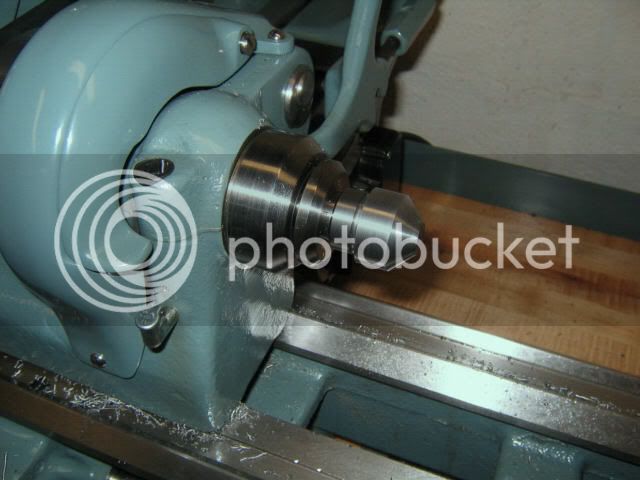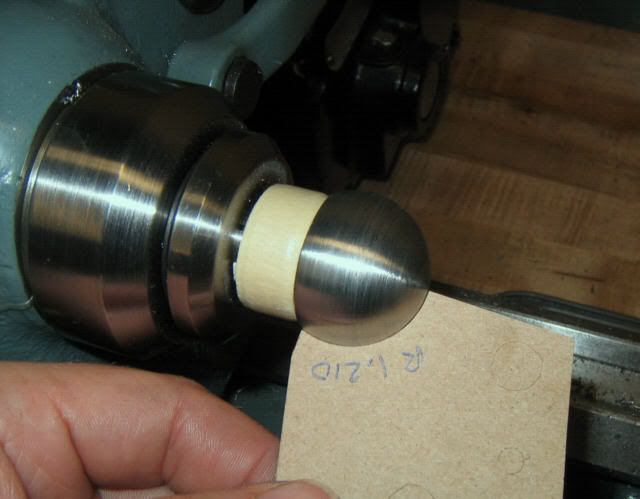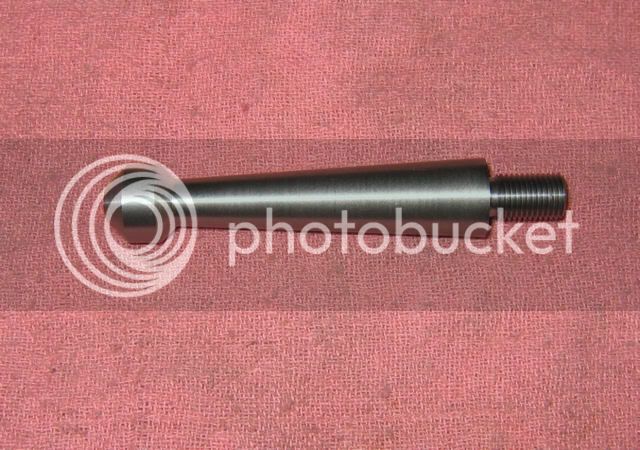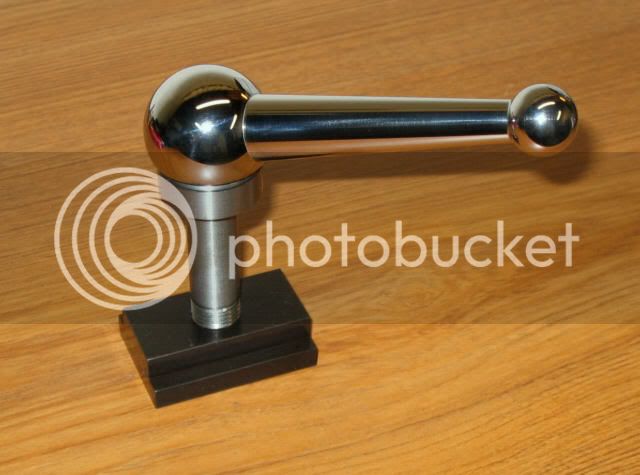I need two steel or brass balls, 1/2" diameter with a blind 5-40 thread in them for a flyball governor I want to make. I don't want to make a ball turner right now. What are my options. If I can find an old bearing with 1/2" balls, can I heat them cherry red to anneal them so that I can drill and tap them? Does somebody out there with a ball turner want to "volunteer" me a couple?---Brian
You are using an out of date browser. It may not display this or other websites correctly.
You should upgrade or use an alternative browser.
You should upgrade or use an alternative browser.
Steel or brass balls without a ball turner
- Thread starter Brian Rupnow
- Start date

Help Support Home Model Engine Machinist Forum:
This site may earn a commission from merchant affiliate
links, including eBay, Amazon, and others.
rickharris
Well-Known Member
- Joined
- Jan 19, 2008
- Messages
- 313
- Reaction score
- 0
Hi,
you can soften ball bearings - Get a good red hot and cool as slow as possible, Overnight in the ashes is good.
Otherwisw use the ball bearings as a pattern make a plaster 2 part mould and cast some auto body filler - USE JB weld seems to be the option. it works like metal when its set - slightly lighter - about 50% !
you can soften ball bearings - Get a good red hot and cool as slow as possible, Overnight in the ashes is good.
Otherwisw use the ball bearings as a pattern make a plaster 2 part mould and cast some auto body filler - USE JB weld seems to be the option. it works like metal when its set - slightly lighter - about 50% !
You can buy brass balls from McMaster
http://www.mcmaster.com/
Just search for brass balls, 10 pack for $ 6.27!
Mike N
http://www.mcmaster.com/
Just search for brass balls, 10 pack for $ 6.27!
Mike N
compound driver 2
Well-Known Member
- Joined
- Jan 3, 2008
- Messages
- 207
- Reaction score
- 1
Start with a bit of EN1a the diameter of the balls you want, drill and tap the bar the size requiared. Take a length of silver steel and bore it 3/4 of the ball diameter to a depth of 1/2 inch. grind the end of teh new foprmed tube dead square and harden followed by tempered to straw.
Step cut the En1a to form a stepped semi ball shape and the use the hard silver steel tube as a hand held cuitter to form teh ball. Its the way its always been done on small govenor balls.
Cast plastic will have no weight and not work as a govenor!
Step cut the En1a to form a stepped semi ball shape and the use the hard silver steel tube as a hand held cuitter to form teh ball. Its the way its always been done on small govenor balls.
Cast plastic will have no weight and not work as a govenor!
Tin Falcon
Well-Known Member
- Joined
- Jul 9, 2007
- Messages
- 7,207
- Reaction score
- 788
As far as anealing bearings rick is right cool slowly vermiculite also works as an insulator or furnace lining blanket such as kao wool or cerra felt.
www. smallparts.com
sells brass, ruby and many other material balls. I would think that brass would be better because of the higher density.
Tin
www. smallparts.com
sells brass, ruby and many other material balls. I would think that brass would be better because of the higher density.
Tin
- Joined
- Feb 17, 2008
- Messages
- 2,326
- Reaction score
- 440
I have bought soft steel balls from this online ebay store. Reasonable prices and quick shipping and they do ship to Canada.
http://stores.ebay.com/ToolSupply/Soft-Polish-Mild-Steel-Balls.html
About US$12 for a package of 25 1/2 diameter including shipping to Canada.
They have assortments in the range you are looking for also.
Gail in NM,USA
http://stores.ebay.com/ToolSupply/Soft-Polish-Mild-Steel-Balls.html
About US$12 for a package of 25 1/2 diameter including shipping to Canada.
They have assortments in the range you are looking for also.
Gail in NM,USA
GailInNM said:I have bought soft steel balls from this online ebay store. Reasonable prices and quick shipping and they do ship to Canada.
http://stores.ebay.com/ToolSupply/Soft-Polish-Mild-Steel-Balls.html
About US$12 for a package of 25 1/2 diameter including shipping to Canada.
They have assortments in the range you are looking for also.
Gail in NM,USA
8400 transactions and a 100% rating. Impressive!
Hi,
The ball inside a computer mouse is a steel (of some sort...) ball with a thin rubber coating. The balls seem to be two standard sizes, most that I have collected seem to be 18mm dia, the smaller size ones are about 15mm (just over half an inch).
Ian.
The ball inside a computer mouse is a steel (of some sort...) ball with a thin rubber coating. The balls seem to be two standard sizes, most that I have collected seem to be 18mm dia, the smaller size ones are about 15mm (just over half an inch).
Ian.
Hi Brian,
There's a seller on eBay called "thesteamchest" who sells bronze balls in various diameters -- might give a more authentic look. I've dealt with them before... very reliable.
The Steam Chest
They also have other hard-to-find model engine goodies.
Paula
There's a seller on eBay called "thesteamchest" who sells bronze balls in various diameters -- might give a more authentic look. I've dealt with them before... very reliable.
The Steam Chest
They also have other hard-to-find model engine goodies.
Paula
Chuck F has "volunteered" me a couple of brass balls. Thanks a million Chuck!!! The brass monkey is safe again for a while.---Brian
mklotz
Well-Known Member
I'm a bit late to this thread but I'll post anyway for the benefit of future readers.
Turning spheroidal shapes incrementally is easy and simple and produces perfectly adequate results as long as high precision is not required.
Download the BALLCUT program from my page and use it to produce a cutting schedule. Using a tool similar to a cutoff tool, one makes a series of plunge cuts to different depths (called out in the cutting schedule) until one has a ball shape with a "terraced" surface.
Slather this shape with Dykem then file until the Dykem disappears, et voila, a sphere of the right size.
No, this won't produce a high precision sphere but in 99% of the HSM's work, ball bearing grade spheres aren't required and this process allows one to make a ball, or hemisphere, of any size in any material easily in the home shop.
Even if you can find a ball bearing of the right size, it will take longer to anneal it than to use this fabrication procedure. Additionally, I've tried annealing bearing balls and it still yields a very tough product. Holding one tightly enough to thread it is a nightmare and broken taps are common.
Buying small brass balls from MSC is a good solution - I have a collection of same which I use when they're of the size required. However, drilling and tapping them requires a jig to hold them. In an earlier post I showed the holder I made to do this. If anyone is interested, I can find that post or repost as part of this thread.
Turning spheroidal shapes incrementally is easy and simple and produces perfectly adequate results as long as high precision is not required.
Download the BALLCUT program from my page and use it to produce a cutting schedule. Using a tool similar to a cutoff tool, one makes a series of plunge cuts to different depths (called out in the cutting schedule) until one has a ball shape with a "terraced" surface.
Slather this shape with Dykem then file until the Dykem disappears, et voila, a sphere of the right size.
No, this won't produce a high precision sphere but in 99% of the HSM's work, ball bearing grade spheres aren't required and this process allows one to make a ball, or hemisphere, of any size in any material easily in the home shop.
Even if you can find a ball bearing of the right size, it will take longer to anneal it than to use this fabrication procedure. Additionally, I've tried annealing bearing balls and it still yields a very tough product. Holding one tightly enough to thread it is a nightmare and broken taps are common.
Buying small brass balls from MSC is a good solution - I have a collection of same which I use when they're of the size required. However, drilling and tapping them requires a jig to hold them. In an earlier post I showed the holder I made to do this. If anyone is interested, I can find that post or repost as part of this thread.
tel
Well-Known Member
- Joined
- Feb 8, 2008
- Messages
- 3,293
- Reaction score
- 44
compound driver 2 said:Start with a bit of EN1a the diameter of the balls you want, drill and tap the bar the size requiared. Take a length of silver steel and bore it 3/4 of the ball diameter to a depth of 1/2 inch. grind the end of teh new foprmed tube dead square and harden followed by tempered to straw.
Step cut the En1a to form a stepped semi ball shape and the use the hard silver steel tube as a hand held cuitter to form teh ball. Its the way its always been done on small govenor balls.
Cast plastic will have no weight and not work as a govenor!
I often use this method, but rather than go to all that trouble I just use wad punches as the tool - they will cut brass just fine.
Also, I have a range of sinker moulds that will produce lead balls in various sizes, as well as several round ball moulds for producing musket balls. Gives me a pretty good range of sizes from .32" up to a bit over 1" and there's noting wrong with lead balls on a little governor.
Marv has it sorted as far as a quick-and-dirty method for turning non-bearing-quality spheres without need of an attachment. And I have used that method with good results.
Recently, I used an even "dirtier" (if not necessarily quicker) method to make a ball clamp lever for a QC toolpost I'm making. In this case, I simply reduced the sphere to a series of tangent surfaces, and used a file to round the corners, checking progress frequently with a radius gage.
Here is the roughed out ball for the stem:

And here it is after using a file and home-made radius gage to get the final shape:

The handle was produced in a similar fashion:

And here's the finished clamp lever (and tee nut) after polishing and assembly:

Paula
Recently, I used an even "dirtier" (if not necessarily quicker) method to make a ball clamp lever for a QC toolpost I'm making. In this case, I simply reduced the sphere to a series of tangent surfaces, and used a file to round the corners, checking progress frequently with a radius gage.
Here is the roughed out ball for the stem:

And here it is after using a file and home-made radius gage to get the final shape:

The handle was produced in a similar fashion:

And here's the finished clamp lever (and tee nut) after polishing and assembly:

Paula
Did you guys know where that saying "Cold enough to freeze the balls of a brass monkey" came from?? In the British navy (about the time of Lord Nelson) when cannons fired round steel balls, the "Brass monkey" was a fixture made from concentric rings of brass, that cannon balls were stacked in to keep them from rolling around the deck when the ship was rolling in heavy seas. If the weather went below freezing, flying spray from the ocean waves breaking against the bow of the ship would freeze on the "brass monkey", and make it slippery enough that the cannon balls would slip out and go careening around the deck of the ship----thus "Cold enough to freeze the balls of a brass monkey'!!!
Another sphere-on-end-of-rod making method I've heard of is to set up a flycutter or boring head on a mill to cut a hole of the ball-size required-- trepan-style I think would be best. Then take a spindex or similar with the parent stock in it and mount it at an upwards angle to the mill head. Rotate the spindle of the spindex while cutting with the mill. The idea is the angle protects the stem of the ball from being cut off while allowing the cutter to do a full circle of the circumference of the ball. I've not tried it, but saw a video once that didn't look too complicated. Marv probably can whip up a program to sort out the required angles for a given stem and ball size.
mklotz
Well-Known Member
Brian Rupnow said:Did you guys know where that saying "Cold enough to freeze the balls of a brass monkey" came from?? In the British navy (about the time of Lord Nelson) when cannons fired round steel balls, the "Brass monkey" was a fixture made from concentric rings of brass, that cannon balls were stacked in to keep them from rolling around the deck when the ship was rolling in heavy seas. If the weather went below freezing, flying spray from the ocean waves breaking against the bow of the ship would freeze on the "brass monkey", and make it slippery enough that the cannon balls would slip out and go careening around the deck of the ship----thus "Cold enough to freeze the balls of a brass monkey'!!!
Sorry, Brian, but that's pure BS. See Snopes...
http://www.snopes.com/language/stories/brass.asp
Well, Mr. Snopes can stick to his story, I'll stick to mine. Besides, if all the stories I told were based on absolute truth rather than entertainment value, I wouldn't be nearly as interesting a fellow as I am!!! ;D ;D ;D
Brian,
take the roller out of a old mouse, cut the rubber of of it and it will yeald a steel ball about 0.68 dia.
They are mild steel and can be drilled and taped and finish up real nice, like chrome when done with 600 and 800 grit sand paper.
take the roller out of a old mouse, cut the rubber of of it and it will yeald a steel ball about 0.68 dia.
They are mild steel and can be drilled and taped and finish up real nice, like chrome when done with 600 and 800 grit sand paper.
Similar threads
- Replies
- 7
- Views
- 1K
- Replies
- 14
- Views
- 1K
- Replies
- 31
- Views
- 3K
- Replies
- 1
- Views
- 1K



